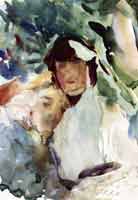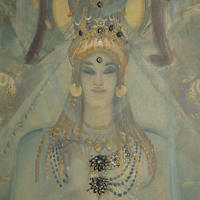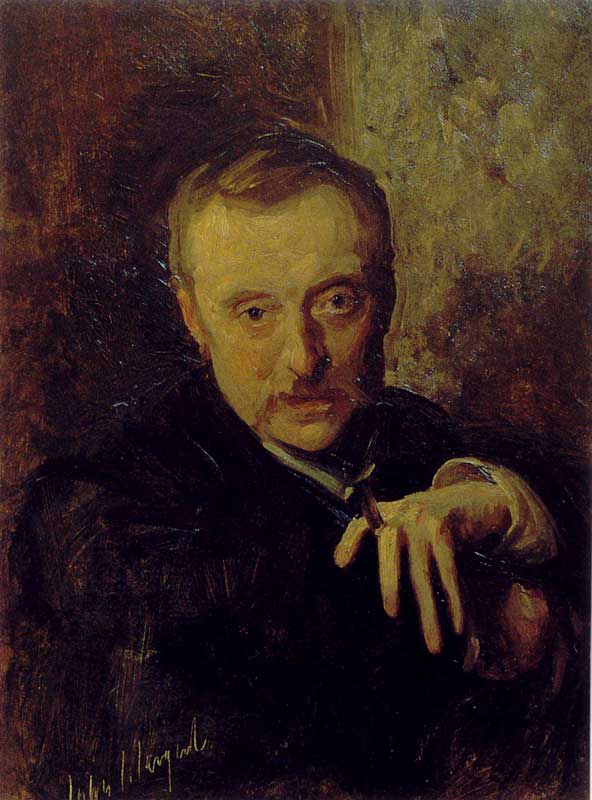Antonio
Mancini
John Singer Sargent
-- American painter
c.1898
Galleria Nazional
d'Arte Moderna, Rome
Oil on canvas
67 x 50.5 cm
(26 1/2 x 19 3/4 in.)
Inscribed
Jpg: Local
Painted in
little more than one hour with heavy impasto, in
tribute to a friend and follow artist: Antonio Mancini (1852-1930) who
was an Italian impresisonist who used heavy paint and expressive brush
work.
Supposedly, the
painting was given to Antonio (the sitter) in
appreciation as a gift, who in turn inscribed it (sometime later in
London) under Sargent's signature with the words: "Mancini ringrazia /
devotamente Mr Sargent / che e così buono / con il pittore
cattivo Manciney / Londra" [English
translation]. -- It was then dated, but illegible to us
now.

Eva Wertheimer/Antonio Mancini
1904
Mancini then
gave the painting away to the cook of Asher
Wertheimer -- both men knew the Wertheimers well -- you can see Sargent
had painted him with one of Wertheimer's daughters in '04. Somehow,
sometime, Sargent's gift made it's way back to Sargent -- it's thought
by Asher Wetheimer. Mancini's inscriptions is known because it's shown
up in photos of the painting in Sargent's studio, but it has since been
cut away -- believed done by Sargent.
John, we know,
believed Mancini to be a great painter and
Sargent went to great lengths to promote the artist to clients. To have
his gift find its way back with that inscription and knowing his
friend's history of melancholy and emotional instability would have
been tough.
When exactly the
painting made its way back, we don't know.
But Sargent kept it with his personal collection (uncropped, or at
least long enough to be caught in a photo), along with a number of
paintings by Mincini (which he cherished) and only near the end of his
life -- and in honour to his friend -- did he part with it -- as a gift
(less the Mincini's inscription) to the Galleria Nazional d'Arte
Moderna, Rome, in 1925, where it would pay proper tribute to his friend
and painter.
(Ormond and Kilmurray; Portraits of the
1890s)
* * *
He was born in
Rome in 1852 and at an early age of twelve
(‘65) was registered at the Naples art academy "Istituto di Belle
Arti." By the time he was only eighteen (‘70) and without ever having
been there, he had his first painting hanging at the Paris Salon. He
graduate from the academy in '73 and he and his friend Vincenzo Gemito
went in together on a studio in Napels. He spent much of his time
painting dancers, street performers and homeless children.
His first trip
to Paris came in 1877 when he met a number of
the French Impressionist – possibly meeting Sargent at this time as
well. He was so taken by what they were doing that he loosened his own
brushwork and more often lightened his pallet thereafter with heavy
- heavy impasto. Like most artists, Mancini struggled financially until
a
Dutch painter and collector Hendrik Willem Mesdag stepped on as his
benefactor (’85) signing him to a contract.
Sargent also
actively encourage him to come to London where
Sargent could introduce him to a number patrons.
he really had a
flair for the theatrical in his composition
-- "After
the duel" of course, being one of the more obvious examples.
Walter
Richard Sickert, a mutual friend of both Sargent and Mancini,
explained Mancini’s sometimes very unusual method in 1927:
His
paintings were
done through a wire grille, whose squares correspond with a grille
before the sitter. The marks of the grille remain. The sitter being, as
it were, pinned down, retained of his mobility alone the facial
expression. But, trembling and snorting within that restriction, there
is an extraordinary vivacity, there is power and a dashing impasto.
(nmgw.ac.uk)
This can be seeb
best in his panting of "de Lafenis".
Not only did he
employ this unusual method but he also used
materials such as shards of glass, and foil within the paint to give
the painting
more illumination -- again "de Lafenis"
is
a documented example.
(Dordrechts
Museum)
It may have been
Antonio Mancini
who influenced Sargent to incorporate things such as glass and other
elements in his Boston Public Library murals.
John
Singer Sargent

Pagan
Gods detail of Astarte
Antonio died in Rome in
1930. In 1940 a major Memorial Exhibition was held in Turin.
Notes:
Exhibitions
Sargent
and Italy, 2002-2003
[CLOSE FRAMES]
Froum
From: Bill
Angresano
an gr es@optonline.net
Date: Wed, 02 Feb 2005
What a beautiful
website, maybe I overlooked mention of one
of Sargent's most significant friends AND influences Antonio Mancini.
Could you shed some light on that? I will certainly tell you everything
I know.
Irma Gilgore is
one of the foremost experts in America on
Mancini and besides helping write a book, owns more paintings of
Mancini then any other American and has a MUSEUM in Florida!! Devoted
to 19th century Italian art.
Let me tell you
how I first got to know of Antonio Mancini
artist, it was in Boston at the SARGENT show years back with a fellow
painter and friend. We went to see that show and Fredrick Maulhaupt a
cape Ann painter. Well we had time to kill and visited Isabella Gardner
museum in Boston and when I first saw Mancini's "The Standard
Bearer for the feast" [n/a] I nearly cried it was so beautiful,
well done emotional and powerful! Who the heck is this guy? I wanted to
know, I found out quite a bit, Sargent loved his work and his portrait
approach and said as much when you read his letters regarding Mancini.
When we were
done at Gardner Museum we went back to the Fine
art museum (Boston) and other than the Sargent show the first room I
walked into I was magnetized towards a life sized painting of a half
naked man on a large rock with staff in his hand, powerfully painted
thick brushy accurate strokes and values and anatomy and etc etc etc I
was floored who painted this some old old Master? No Antonio Mancini
did and the painting was St.
John the Baptist
Whew! I was
floored .
Since then I
make it my business to hunt down any and all
images and reading regarding this exceptional artist.
Let me know what
you find much luck and congratulations on
your website!
From:
Natasha
. . .As to
Mancini I love him for a lot of reason, that he
is a wonderful painter as you say is only one of them but just as a
story he is such a great guy to try to understand – I love the pathos
of it, and that Sargent was such a strong supporter of him is telling,
I think.
From: Bill
Angresano
Let's stay in
touch Natasha, I respect your devotion and
love of Sargent his art and technique and that wonderful turn of the
century when painters knew and shared lives and work with each other.
Next week I
start a commission to paint a World Boxing
Champion named Arturo Gatti who lives in Hoboken I will share any
photos that occur from the sittings, HBO Network is sending a
photographer to witness.
I will send you
examples of my work for conversation sake.
Your 100 percent right when you say Mancini was a character in the true
sense of the word!! His portraits rival the greatest of all time very
emotional very candid, honest portrayals.
Blessings,
Bill
P.S.
Mancini like Jules Bastien Lepage, Fortuny, L'Hermitte and Dagnan
Bouveret are way over due for a retro show
|




